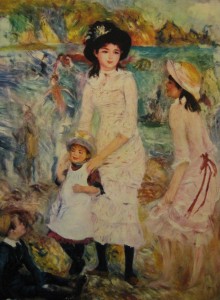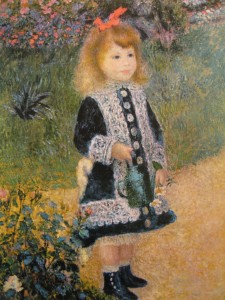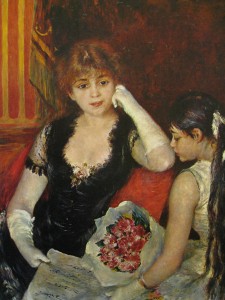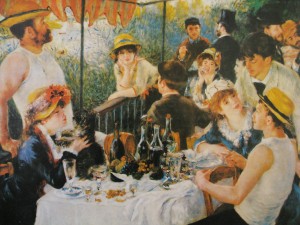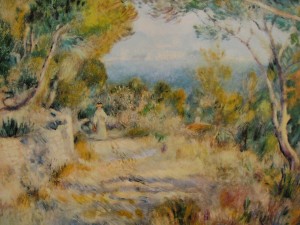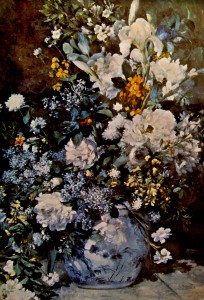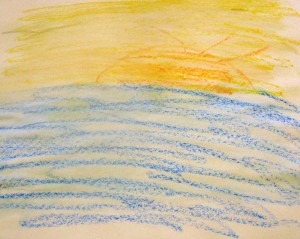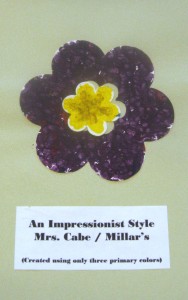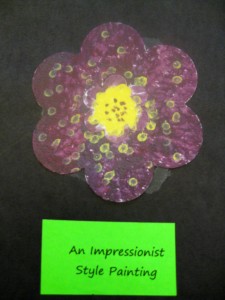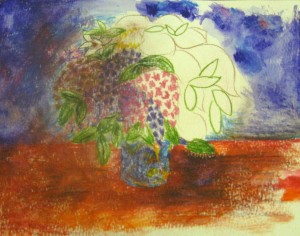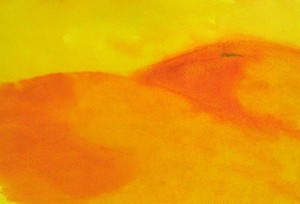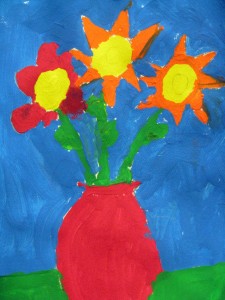2. Monet Painting in His Garden at Agential
5. Luncheon of the Boating Party
6. L’Estaque (pronounced ill-es ta kay)
Packet Extra:
Sample Projects:
It used to be that if you wanted to be successful as an Artist, you would submit samples of your paintings to the “Official” Great Salon, in Paris. There, official “art experts” could make or break your artistic career by accepting or refusing your work. Almost the only way an artist could become well known in the 1800’s was to have their paintings shown in the Great Salon. People came to the Salon from all over the world, to see what the best artists in the world were doing.
Starting in 1863, the Salon des Refuses, in Paris, began showing the work of artists who had been rejected by the “Official” Salon. In 1874, Claude Monet, a friend and painting companion of Renoir’s, exhibited a painting titled Impression; Sunrise with some of his “refused” artist friends in the Salon des Refuses. The painting was criticized for being “just an impression”, or an unfinished picture. This was meant as an insult but the artists adopted the word as a title for their group—“IMPRESSIONISTS”.
Renoir is credited, along with Claude Monet, for creating the artistic Style of Impressionism. The two were the leaders of a group of young artists who left dark studios to paint scenes of everyday people in natural outdoor lighting. The style was shocking to the Paris art world at the time, but is still popular today.
Renoir and his friend, Monet, produced their first Impressionist paintings during the summer of 1869. One Sunday they took their paints outside to a park and painted. Sketching, then painting the entire picture outside was a very new approach to painting. Before this time, the picture had to be painted in the studio because it was a messy job mixing up each paint color. Separate colors were stored individually in a pig’s bladder, a temporary container, not sturdy enough to be portable. By 1869, metal paint tubes had been invented, similar to a toothpaste tube. These tubes made oil paint more convenient and portable.
STYLE is the focus this month. Renoir and Monet decided to let the eye do the color mixing, just as it does with sunlight. Examine the pictures closely to observe how a solid COLOR in a Renoir painting is actually created with tiny “dabs” of a variety of colors. Painting this way, in the Impressionist Style, makes these colors flow together and glow with life as the human eye naturally blends them. To be sure that his colors were pure, Renoir used a separate brush for each individual color. Impressionist paintings might seem a little “out of focus” at first, but as you step away, the pictures become clearer.
Make sure ALL 7 pictures are returned to the Packet Carrier after your Presentation is finished.
Pierre-Auguste Renoir
Pierre-Auguste Renoir was born September 15, 1841 in Limoges, France, which was just outside the city of Paris. His family soon moved so he grew up in Paris and lived very close to what had once been the Royal Palace of the French King and Queen. The palace was called The Louvre (loove) and when Renoir was little, it had been a museum for many years, which is what it remains today. Renoir’s mother sometimes took him to The Louvre. He loved the beautiful paintings and sculptures he saw there and the art of the Louvre made a major impact on him that changed his life forever.
Pierre-Auguste was the youngest of five children. His father was a tailor and their family did not have a lot of money. They lived in a home with three small rooms. One of these rooms was their father’s tailor shop in the daytime and little Auguste’s bedroom at night. There Auguste slept on a wooden workbench and, if he forgot to wear his slippers, he might poke his feet on the scattered pins that were often dropped on the tailor’s workroom floor.
Young Auguste began drawing at school, all over the pages of his workbooks. One day at home he borrowed his father’s tailor’s chalk and drew pictures on the floor. His parents were angry at first; tailor’s chalk was expensive. When they looked more closely at the chalk pictures, Renoir’s parents discovered that their son had a special talent. His parents managed to find enough money for pencils and paper and soon their youngest son was drawing portraits of everyone—his brothers, his sister, the neighbors, even the neighborhood cats and dogs.
Auguste was 13 years old when he left school to begin his first job. He became an apprentice in a porcelain factory, learning to paint beautiful pictures on porcelain.
Do you know what porcelain is? Special dishes, plates, cups, bowls, vases and statues are made of porcelain. Porcelain is very delicate and easy to break type of china. It was decorated with small, delicate paintings, most often flowers.
Renoir would paint the decorations on the porcelain. Renoir’s father hoped his son’s talent would make him a Master Craftsman in the porcelain painting business.
Renoir started this job by painting flowers on porcelain, but was so good that soon he was painting Portraits of famous people on the delicate pieces. He thought his career would be painting porcelain, but soon machines were able to paint these delicate dishes and vases. The machines could paint every dish exactly the same and machines were much faster than people were, so the porcelain painters lost their jobs.
Renoir had learned to use a brush with precise detail and how to appreciate the beauty of bright colors during the time he spent as a porcelain painter. He found several different jobs earning money with his paintbrush after the porcelain factory. Have you ever seen little folded fans that people can wave to cool themselves? For a short time, Renoir painted fans and decorations on window blinds, until he saved up enough money to go to art school. He even decorated the walls of a café. He was about 19 years old when had earned enough money to begin art school.
Art school taught Renoir a lot, but sometimes he thought the paintings in the museums were kind of old fashioned. He was always experimenting with better ways to paint. Renoir painted the way he felt he should and not always the way his teacher wanted him to paint.
Renoir made many new friends at the art school. He discussed new ideas about art with his friends. Together, they decided that there should be a new way to paint. In a few years the ideas of these young artists changed painting, not only in France, but all over the whole world!
Renoir and his friend, Monet, produced their first impressionist paintings during the summer of 1869. One Sunday they took their paints outside to a park and painted. Renoir noticed that trees and flowers bathed in sunlight looked especially beautiful. He decided to try to imitate this quality of sunlight in his pictures and kept painting outside. Sketching, then painting the entire picture outside was a very new approach to painting. Before this time, the sketch had to be painted in the studio because it was a messy job mixing up each paint color. Other artists usually sketched outside and returned to their dark studios to paint the final picture. This was partly because separate oil colors were stored individually in a pig’s bladder, a temporary container, not sturdy enough to be portable. By 1869, metal paint tubes had been invented, similar to a toothpaste tube. These tubes made oil paint more convenient and portable.
Other artists mixed all the colors on their palettes, before painting the color on the canvas. Renoir and Monet decided to let the eye do the color mixing, just as it does with sunlight. The artist “dabbed” various colors next to each other. From a distance, the human eye naturally blends these colors and they seem to glow with life into one solid color. To be sure that his colors were pure, Renoir used a separate brush for each individual color. Impressionist paintings might seem a little “out of focus” at first, but as you step away, these pictures become clearer.
At twenty-three Renoir began showing his pictures in the Paris Salons. Nobody bought Renoir’s paintings for a long time. He felt sorry for people who couldn’t yet understand what he had discovered about the beauty and appearance of color in the sunlight. Artists need to sell their paintings in order to earn money. Renoir never had much money and often could not pay his rent and had to move. At times he was so poor he could not even buy paints. Whenever he sold a picture, he made only enough money to live on. Because money was always a problem, Renoir had to live in the garrets (attics) of old cottages, in a poorer area of Paris, located on a hill high above the city, called Montmartre (Moh MAR truh). Here, he painted the people who lived around him, especially the working girls and young children.
After awhile, his work began to win friends. Madame Charpentier, the wife of a famous book publisher, asked him to paint a portrait of herself with her children. She invited him to her parties and her friendship won Renoir other customers. The artist met Aline Charigot, a pretty girl about 20 years younger, in 1880. Aline had been his favorite model and she posed in his impressionist masterpiece The Luncheon of the Boating Party. In 1882, at the age of forty, Renoir finally had enough money to marry Aline.
Before long he and his wife had three sons. Renoir often made his sons the subjects of many of his paintings. The little boys felt that it was a great treat to help Renoir by posing for him or by cleaning his palette and brushes. The boys loved to watch their father painting but they never talked while he was working.
Fame came at last to Renoir, but so did illness. Even though arthritis crippled his hands, he refused to stop painting. The harsh climate of Paris made the pain worse, so he moved to the warm south of France and kept painting.
His home there became the destination of many young artists. They visited him to learn and to be inspired. Toward the end of his life they found him with the brush tied to his stiff hand, still painting, looking for newer ways to use color and to understand light. A friend once asked why he continued to paint when it caused him so much pain. Renoir answered his friend saying, “Because, the pain passes, but the beauty remains.”
More of Renoir’s feelings about the art of painting are revealed in these two quotes from the artist: “Oh what a joy to indulge in the exquisite ecstasy of painting…” and “To me, a painting must be an agreeable, joyful, pretty thing…” Renoir died in 1919. He left the world more than four thousand beautiful works of art.
1. “Children on the Seashore” 1883, 1879, 1898
Renoir is known to have stayed on the coast of Normandy in 1879, in 1883, and for the summer of 1898. Today, experts are not sure on which visit the picture was painted. Pure landscapes by Renoir are rare. The artist preferred to paint people and common every-day themes in his paintings.
Suggested Dialogue
Where does the viewer’s eye go in this painting? Notice how the girl’s arms, the boy’s legs, and the beach in the background serve to make a core area, a frame, in the center of the painting.
What is the FOCAL POINT of this painting (EMPHASIS)? Where do your eyes want to focus? Notice the contrast between the tall girl’s black hat and her face/eyes. Her face is the focal point of the picture because of color (contrast) and lines (the framing). The focal point is usually the brightest area in a picture.
Notice the waves and ocean colors on either side of the girls. Are the brush strokes visible? Are the colors uniform? Or are they blended? Was this intentional? What effect does it have?
Can you see how “the public” looked at the Impressionist paintings and considered them raw and unfinished?
Project Ideas
Packet 14. Renoir Line drawing
- Create a make believe painting of yourself with some friends at the beach.
- Paint a seascape.
- Sculpt a sandcastle.
2. “Monet Painting in His Garden at Argenteuil” 1873
Monet and Renoir were friends, who painted and studied together. The Impressionist style was developed as a way to capture the quickly changing sunlight outdoors. Renoir and Monet often painted in the countryside together. Many of the scenes these two friends painted together during those days are so similar in style that, when they were older, the two artists had a hard time telling their own paintings apart. The major difference in each artist’s work was that Renoir went on to paint mostly Portraits, while Monet continued with Landscapes.
Impressionism portrays colors more vividly because the artist lays the colors close together, so that the viewer’s eyes blend them together, instead of the paintbrush. Monet painted many pictures of his own garden. This picture shows him painting in his garden. Renoir has captured this artist busy doing what he loved most—painting outdoors.
Suggested Dialogue
What is a Portrait? A picture of a person or an animal
What is a Landscape? An outdoor scene
Where do your eyes go first, to Monet or to the garden? The flowers in the garden, on the left, take up most of the space in the picture.
Point out the way the artist has created MOVEMENT and RHYTHM in this picture. Although our eyes begin at the left of the painting, the evenly spaced rails of the fence create RHYTHM and lead our eyes to the easel, the painter on the right, then back to the garden flowers. Notice the direction Monet’s arm gestures while painting (towards the flowers). His easel legs create lines pointing towards the garden flowers too. These are all subtle ways that the artist moves our eyes through the painting in the direction he wants them to travel.
What seems to be the FOCAL POINT of the picture? Where do your eyes go first? The artist
There are lots of colors, but this is not a bright scene. What time of the year would it be in this picture? Monet seems to have on a coat and a hat, but the flowers are blooming. It is probably early spring or late fall.
Project Idea
- Team up with a partner to draw each other, drawing a picture of each other— another example of a portrait showing an artist at work.
- Look out the window and paint an outdoor scene of the landscape you see there.
3. “Girl and Watering Can” 1876
Children and people were favorite subjects for Renoir. Have everyone close their eyes before you show them the picture. Give them instructions before they open their eyes, that they are to look at the picture you are about to show them and figure out what was the first thing their eyes focused on when they opened them and looked at the picture you were holding.
What is the first thing you see when you look at this painting? Attention is drawn to the girl’s face by the red hair bow and by the lines in her clothing and arm position. Her face is also the lightest and brightest area of the painting, making it the CENTER OF ATTENTION or FOCAL POINT.
Who can describe this painting?
Look at the COLORS. Are they mostly WARM or COOL?
The Impressionists applied quick brush strokes of pure color and placed dabs of COMPLEMENTARY COLORS next to each other to capture the effects of sunlight. Where has Renoir suggested sunlight?
What do you see in the FOREGROUND, MIDDLE GROUND, and BACKGROUND of this picture?
Use your finger to trace the REPEATED PATTERN of the buttons on the girl’s shoes and dress and the rectangles or lace that direct your eye to her face, reinforcing the fact that the face is painted with the most detail. In contrast, the child’s body and the flowers in the garden seem to blur together.
Project Ideas
- Use oil pastels to draw self-portraits.
- Bring in a watering can similar to this and let the kids draw it.
- Plant seeds in a cup and keep them in the classroom until they grow. (Especially good for K-1 kids. Check with the teacher beforehand about his/her ability to keep these growing in the classroom for awhile.)
4. “At the Concert” 1880
Renoir enjoyed painting everyday scenes rather than the very “traditional” Portrait pictures. He often used his family and friends as models in his paintings. He is said to have painted women in the “old traditional style,” putting them in a picture without clothes or in a household setting, often with children. Renoir could get these themes in his Impressionistic Style pictures accepted into the state gallery, The Great Salon, but other more truly Impressionistic paintings would be rejected.
Suggested Dialogue
Who can describe this painting for me?
What is a painting of a person or an animal called? A Portrait
The old masters used to paint in dark studios and do very traditional portraits. What in this picture is traditional? (i.e., the woman and the girl) and what is non-traditional? The pose of the girl and the pose of the woman. They are engaged in doing something, from everyday life, and not just sitting/posing for the artist. The woman’s arms, the concert program, the girl’s arm, hair and body make a smaller frame within a frame.
What colors are predominant in this painting, Warm or Cool? Reds/warm colors
What MOOD or feeling does the choice of color give the picture?
Do you like this picture? Why or why not? There are no wrong answers to this question; it is a matter of opinion. Just be sure everyone backs up their opinion with a reason. This causes kids to think deeper and exercises higher level thinking skills. Even second graders can be asked a question like this, although it may take a little longer for them to explain WHY. Just remember the most important part of the question is WHY you do, or don’t you like the picture. By respecting each child’s opinion, no matter how ridicules, you encourage them to think more. Eventually, their WHY answers will improve as they feel supported and realize everyone is entitled to their own opinion and there is no wrong answer to this question.
Do the woman and the girl seem nice?
Does the painting have mostly COOL COLORS or MOSTLY WARM?
Who can list of the COOL COLORS and WARM COLORS for me?
5. “Luncheon of the Boating Party” 1881
Renoir and Monet worked together in the late 1860’s, painting similar scenes of popular river resorts and views of Paris. Painting people, often using his family and friends as models, captivated Renoir. This painting seems to be both a restful afternoon and a busy luncheon. Renoir shows us interrelationships: the young man on the right listening to the girl talking, the girl on the left with her puppy, the man behind her who is lost in thought, the girl leaning on the rail, listening to the seated man.
Suggested Dialogue
There are many CONTRASTS with the yellows and blacks, blues and orange/red. What feeling or MOOD do these COLORS give the painting? Movement, warmth of the day, pleasant activities
What shapes are used to create a frame within a frame? People’s arms, the awning of the boat (this is a floating or anchored restaurant), the light colors/white in the center and the darker colors around the outside.
Would the traditionalists have accepted this at the “Grand Salon” in Paris? Probably not, it was first a huge picture, over five feet wide and over three feet tall. It was definitely not a posed picture, a traditional portrait. People are everywhere, seeming to be doing just ordinary stuff – not looking necessarily at the artist/viewer, not even stopping what they were doing. The Salon believed group portraits should be correctly posed.
Look at the three people in the upper right corner. The two men are smiling as they are teasing the woman wearing the fancy hat and gloves. The woman is putting her hands over her ears, as if she does not hear them. Since she is so formally dressed in her hat and her gloves, she probably came with the man in the top hat, who is also dressed up. It looks as if they stopped by on their way to somewhere else where the dress is a little more formal.
Now look at the three people talking in the FOREGROUND. One man is leaning over to look at the woman. What are these two doing? They seem to be talking.
The man standing on the far left is the owner of this fashionable, floating restaurant. It was a very popular restaurant in Renoir’s day. The owner’s daughter is in the picture, leaning over the railing. Can you find her? The owner’s son is one of the three sitting in the far right foreground. He wears the hat and has his chair turned around. Can you see the owner’s son?
Renoir’s wife is also in the painting, although she and the artist were not married yet. She is posed holding the dog. Nobody seems to mind that she has put her dog on the table to look it in the eye and talk to it. This indicates they are probably finished eating.
6. “L’Estaque” (ill-es tah kay) 1882
This is the name of a town in France. It was probably painted during a time Renoir spent working there, in 1882, with Paul Cézanne. Cézanne also painted a picture with this name.
Suggested Dialogue
Where does the viewer’s eye go in this picture? There is a person in this picture, but they are not the focus of the picture. What is the focal point? Is there any one focal point?
This picture is painted horizontally, a direction most often used for Landscapes. What is the MOOD of the painting? Serene, quiet, calm, tranquil
What gives the picture feeling or a MOOD? How does it achieve this? The brushwork is so loose that most of the grasses, trees, the woman and even the path she is on, are just suggested. We get the feeling of a warm summery sunny day. There are lots of yellows used for highlights, lots of light colors, blue and off-white. There are only a few areas of dark/light contrast: in the tree trunks and some in the leaves.
Project Idea
Bring in Landscape photographs from an old calendar or travel magazine. Pass one out to everyone and have them draw and/or paint the scene.
7. “Bouquet de Printemps”
What type of Painting is this? Still Life-The flowers are not growing outside, but arranged in a vase.
Can an artist only use flowers in a Still Life painting? No, many inanimate (non-living) objects can be displayed in this type of painting.
Who can tell me some objects that an artist might also include in a Still Life Painting?
Is this Still Life painted with mostly WARM COLORS or mostly COOL? Almost everything in the painting is cool
What specific COLORS do you see in the picture? Different VALUES and TINTS of blue, even the leaves and stems have blue in them (blue-green, an INTERMEDIATE COLOR), There are just a few highlights of yellow (let kids point these out)
Where do you see LINE in the picture? What type of LINE?
What type of TEXTURE do you see in this painting? Rough tiles, smooth ceramic vase
What type of PATTERN can you find? Discuss the type of nature pattern painted on the vase using mostly line.
Project Idea
- Bring in some real flowers or silk flowers and let kids draw and paint a Still Life.
- Bring in other, more unusual objects to create a Still Life arrangement for kids to draw, such as pots and pans, eggs, box of cake mix, and mixing spoons. Another arrangement could be hammer, nails (large), screwdriver, saw. Get creative, Prop a box behind arrangement to lay a solid color towel or piece of fabric so you will have a solid color background that will not detract from the objects. The most interesting arrangements are triangle, tallest object in middle, smaller objects on either side, just like a triangle.
- Bring in objects mostly in a single color scheme. Use a contrasting color to highlight three small areas. Paint the arrangement.

